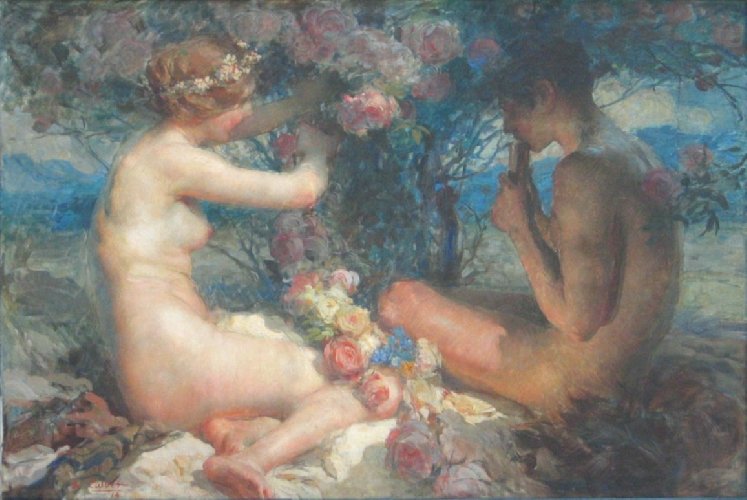Description:
Antoine Calbet (1860-1944) was a French painter, a student of Cabanel, from whom he drew a vivid palette. He was a member of the Société des Artistes Français. He exhibited at Salons. He took a liking to mythical and ancient themes. He also did book illustrations. His painting style is reminiscent of 18th century works*.
Description of the painting: Daphnis and Chloe are the protagonists of the ancient romance by Longos. There is no certainty as to the authorship of the work or the time it was written, which is given as a range from the 3rd to the 5th century AD. Until the 19th century, the work survived in a damaged form, deprived of a significant part of the text. In 1809, the French writer Paul Courier found a pastoral manuscript in the Florence Library of St. Lawrence and copied the missing verses. It turned out that contrary to Goethe’s assumptions, the missing fragments were quite extensive – about 6-7 pages and contained an essential description of Daphnis and Chloe’s budding love**.
The pastoral presents the story of the love of two shepherds. The figure of Eros wraps the pages of the work. But not only love, both in spiritual and physical dimension, becomes the hero of the romance. When Chloe is taken by the invaders, all nature takes part in her salvation. She “lives together with these children, who grow like her most beautiful flowers. She wreathes them with colored wreaths of spring, brings their bodies closer to each other with the heat of summer, separates them with cold hands of winter. ”**.
Calbet probably presents one of the initial scenes, in which between the painted, naked figures of shepherds a feeling begins to arise. Daphnis plays the flute, Chloe weaves a rose garland, picking pink buds from the bush, in the shadow of which the lovers hid. The composition of the work, the placement of the characters on two opposite sides of the tree evokes associations with the analogous posing of Adam and Eve around the Tree of Knowledge of Good and Evil in the Garden of Eden. However, in Calbet’s view, the woman and man created for each other live in perfect harmony with the surrounding nature. They obey its laws. They are happy.


